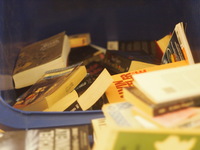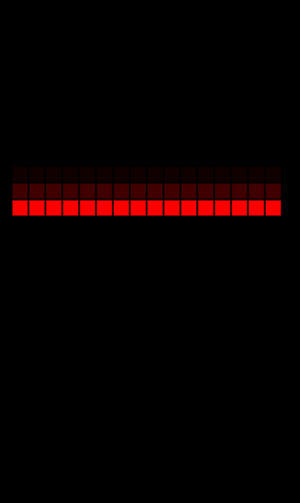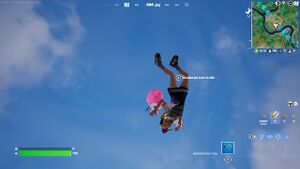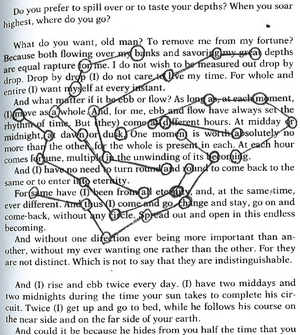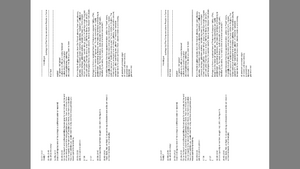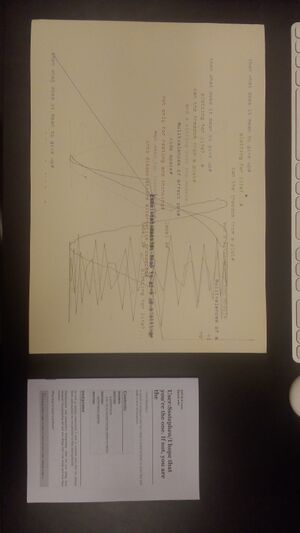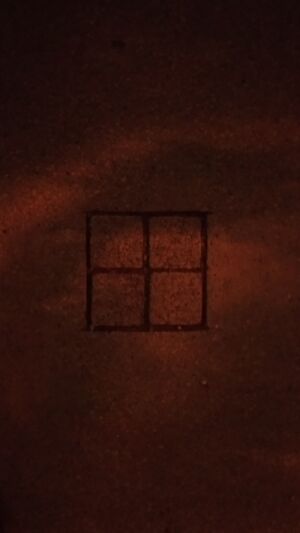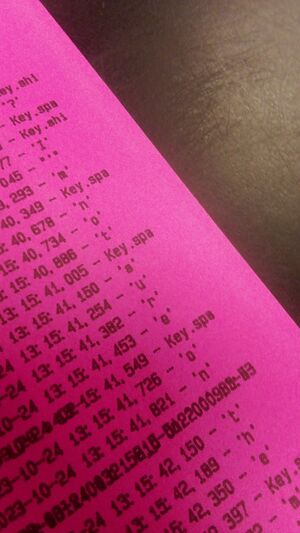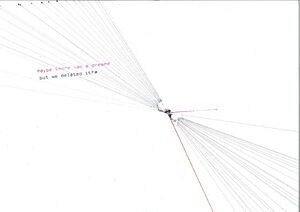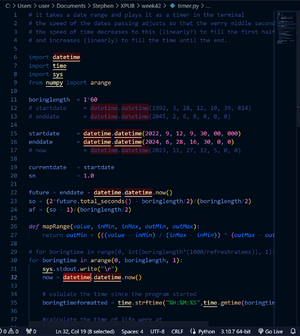User:Ssstephen/34
0:00–0:30 20220912–20221207
0:30–1:00 20221207–20230227
1:00–1:30 20230227–20230427
1:30–2:00 20230427–20230623
2:00–2:30 20230623–20230810
2:30–3:00 20230810–20230918
3:00–3:30 20230918–20231019
3:30–4:00 20231019–20231110
4:00–4:30 20231110–20231123
4:30–5:00 20231123–20231127
5:00–5:01 20231127 12:21:00 – 20231127 12:21:01
now
5:00–5:30 20231127–20231129
What do you want to make? An assessment of what a ⊞er does, through autoethnographic and academic research. This could be expanded to other people or groups that relate to or interact with ⊞ as a category and label. This assessment will take the form of unusual forms of research such as keylogging, performance of personal work habits, and casualinterviews. The research could be represented to interested parties such as graphic designers, architects, musicians or other creative practitioners. For example this week I made a small booklet intended to start future conversations on this topic and posted it to designers, printers, musicians and an architect. how can i describe these things without pointing to work already done? general question about writing project proposals
Secondly, a collection of tools that highlight, stretch, decompartmentalise, undiscipline, annotate, break, cross, laugh at, question, dissolve the boundaries that exist around this apparent object. At the moment these seem like two separate things. They also seem to each consist of lots of little things maybe more as vague constellations rather than fixed objects or even categories. This is intentional.
The main ways these two approaches relate in my head is the second being answers or responses to questions or uncomfortable knots that come up in the first. However as both parts are formed of smaller elements I hope they will respond to and compliment eachother in more squishy friendly combinations that will show up along the way.
Assessment, autoethnography: I have been documenting my practices on this page. I am experimenting with different ways of doing this, so far all based on text annotations. I plan to expand the methodology further to get a wider view of the practices. It could also be possible to document the practices of others, for example through interviews.
Undisciplined tools: Software and hardware tools that interfere with the boundaries as described above. I want to make small prototypes that make a point. I want to review these prototypes and see what they do. For example at the boundaries between ⊞ and other disciplines. At the boundaries between work and play. Taking inputs or sending outputs where they are not traditionally connected.
5:30–6:00 20231129–20231206
How do you plan to make it? Interviews I will conduct with designers, architects, musicians, etc. in Ireland the Netherlands and wherever else seems relevant. online and offline. I will record the interviews. I will have prompts to open the discussion such as reading material and weird tools to try with them. I will carry out auto-ethnographic research using experimental methods such as mouse tracking and unusual annotation methods. I will share the results of this research as a publication with a small but selected audience of people who are involved in these processes and who would may benefit from it.
Small prototypes of tools which I will test myself as I build them.
6:00–6:30 20231206–20231217
What is your timetable? interfere with boundaries check if someones done it copy them breathe out grad show June write May assessment focus based on findings make tools April be undisciplined struggle prototype March be transdisciplinary make connections reading make HPGL functions February change direction play think of more connections January break InDesign talk to designers remember a rehearsal rest December breathe in review interviews work break tools November autoethnography expand do interviews write a sentence every minute make jians module contract
6:30–7:00 20231217–20240101
Why do you want to make it? From personal experience and anecdotal evidence from others, as well as an increasing literature on the topic (Ruben Pater, Silvio Lorusso), there are obviously some problems with our understanding of design today. There is a disconnect between the narratives about the practice and the effects it is known to have, on its audiences, practitioners, and society in more general terms. People are reassessing what ⊞ even is and also what it can be. This shit could be better. Its urgent for the people being exploited by it, to break the inequalities it serves to maintain, to expose what it hides, to improve things that are definitely working but not in a good way. Yes I have skin but it is full of pores, it is surrounded by and surrounding hairs, it is completely empty.
7:00–7:30 20240101–20240120
Who can help you and how? Marloes, I dont really know how to write a project proposal for example. Joseph and Manetta, with technical aspects of the tools, and technical approaches to documentation maybe. People involved in other practices (disciplines) who could help me explore crossing these boundaries. Writer contacts in Ireland. OSP. Michael. Jian. Frank. Jonathan. xpubs. There are probably more. Maybe I will ask Meghan Clarke I really like her work and it seems relevant.
the people in the interviews this week. xpub1 will critique.
why are these things relevant?'
7:30–8:00 20240120–20240213
Relation to previous practice I have worked and been trained as a ⊞er. I have also worked and been trained as a musician, a theatre maker, a teacher, a web developer. The boundaries have never been clear. I'm not sure will this make them clearer or fuzzier. Hopefully bring the fuzziness into focus, without expecting it to be clear.
Needs more previous projects and description of how they relate to this
8:00–8:30 20240213–20240312
Relation to a larger context OSP. Ruben Pater. Meghan Clarke. The context of design studios and institutions I was involved with in Ireland. The context of other workers who relate to and struggle under systems and labels like "self-employed", "freelance", "creative". This also makes me a little uncomfortable as most of these workers including me come from an extremely privileged position of literal wealth and other advantages which allow them to operate in these fields. I dont want to suggest their struggles to be worse than or even comparable to those of many others people currently on this planet. But the topic relates to larger societal developments of precarity that are worth examining and challenging, so I will do this from my own practice and experiences within the creative industries.
8:30–9:00 20240312–20240413
References/bibliography Jian's work from last year, as well as Supi, Emma, and Kim.
Caps Lock, Ruben Pater This book is about ⊞ from several different contexts. It's chapter headings show that it examines the "⊞er as" (salesperson, worker, amateur, activist, etc). It has given me so far lots to think about in terms of the ⊞er's role in society, particularly through a Marxist lens. Further Reading: 'The Politics of Design: A (Not So) Global Design Manual for Visual Communication 2016'.
16 case-stories re-imagining the practice of lay-out, Open Source Publishing This is relevant to the part where I want to examine the eco-system of tools that surround me, and make tools that play with the boundaries and possibilities. It includes some really interesting experiments in the same spirit. I need to read it again because it gave me loads of fun ideas.
Death of a Son, Jon Silkin
I have seen stones: I have seen brick
But this house was made up of neither bricks nor stone
But a house of flesh and blood
With flesh of stone
And bricks for blood. A house
Of stones and blood in breathing silence with the other
Birds singing crazy on its chimneys.
But this was silence,
The "Moralities" of Poaching. Manufacturing personal artefacts on the factory floor, Anteby, M. Case study of the weird boundaries or connections between labour and the rest of existence ("leisure"). Situating labour within bigger social structures. It would be interesting to work through a similar lens.
Notes on: De Certeau, M.(1984) The Practice of Everyday Life, Dave Harris And also the
9:00–9:30 20240413–20240520
i dunno
9:30–10:00 20240520–20240628
finished (-.-)Zzz...

